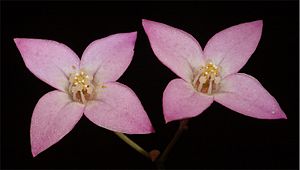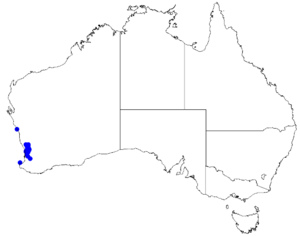Boronia ovata facts for kids
Quick facts for kids Boronia ovata |
|
|---|---|
 |
|
| Scientific classification | |
 |
|
| Occurrence data from Australasian Virtual Herbarium |
Boronia ovata is a special plant that belongs to the citrus family, called Rutaceae. It grows only in the south-west part of Western Australia, which means it's endemic to that area. This plant is an open shrub with simple, egg-shaped leaves and pretty pink or mauve flowers that have four petals. You can find it growing in the Darling Range near the city of Perth.
Contents
What Does It Look Like?
Boronia ovata is an open shrub that can grow up to about 40 centimetres (16 inches) tall. Its leaves are broadly egg-shaped and around 10 millimetres (0.4 inches) long.
The flowers grow in small groups at the ends of the branches. Each flower sits on a thin stalk called a pedicel, which is about 5 to 15 millimetres (0.2 to 0.6 inches) long.
Each flower has four red sepals, which are like small leaves that protect the bud. They are broadly egg-shaped with a pointed tip and about 2.5 millimetres (0.1 inches) long. The four petals are pink to mauve, oval-shaped, and about 8 millimetres (0.3 inches) long.
Inside the flower, there are eight stamens, which are the parts that produce pollen. They are smooth and have an anther (the part that holds pollen) about 1 millimetre (0.04 inches) long with a tiny white tip. The stigma, which receives pollen, is very small. Boronia ovata usually flowers from September to November.
Where Does Its Name Come From?
The plant Boronia ovata was first officially described in 1841 by a person named John Lindley. He published its description in a book called Edwards's Botanical Register.
The second part of its name, ovata, is a Latin word. It means "egg-shaped," which describes the shape of the plant's leaves.
Where Does It Grow?
This type of boronia plant grows in eucalypt woodlands. You can find it in the Darling Range, an area between New Norcia and Boddington. These areas are part of different natural regions in Western Australia, including the Avon Wheatbelt, Jarrah Forest, and Swan Coastal Plain.
Is It Endangered?
The Western Australian Government's Department of Parks and Wildlife has looked at Boronia ovata. They have classified it as "not threatened," which means it is not currently in danger of disappearing.

